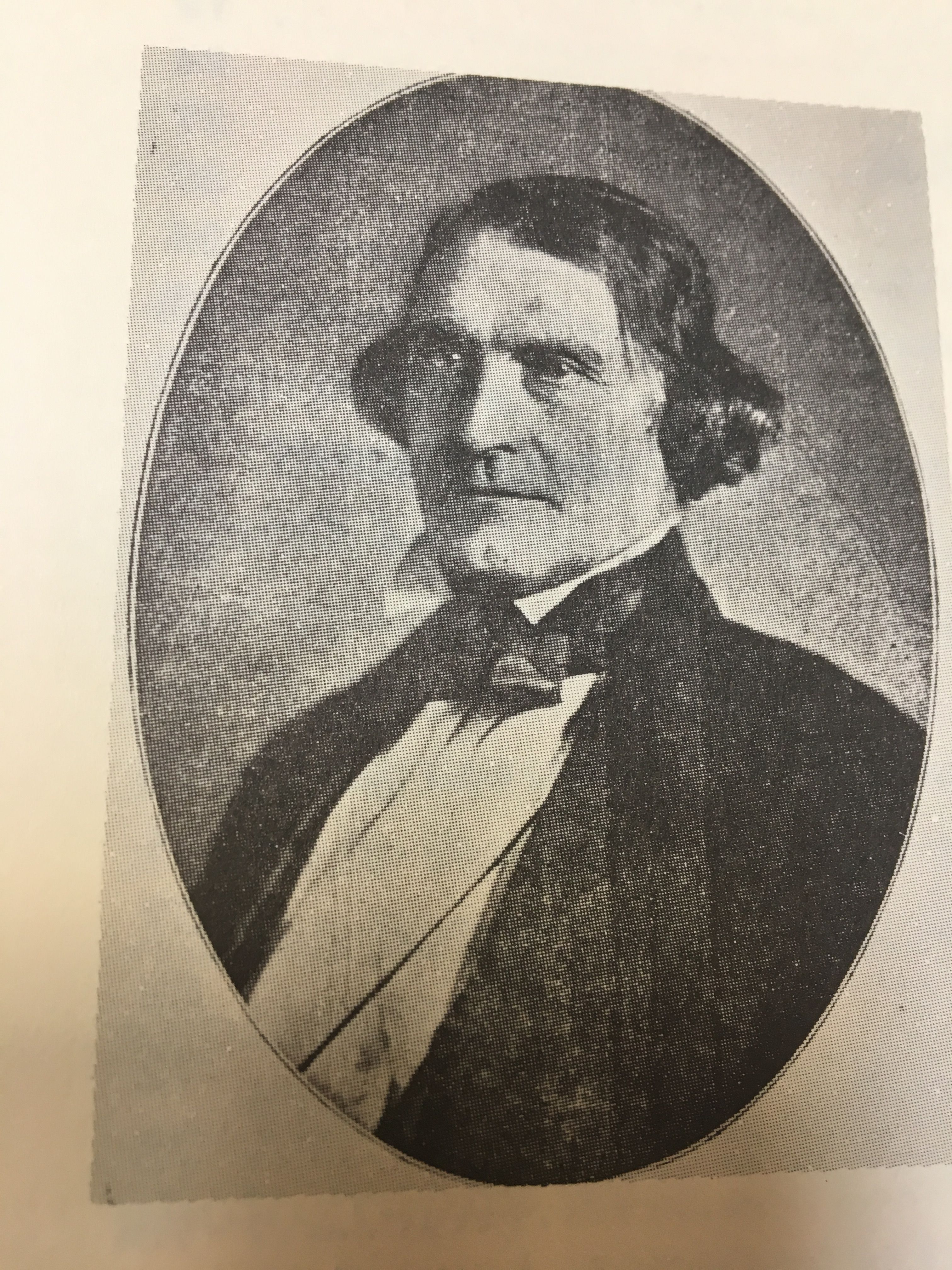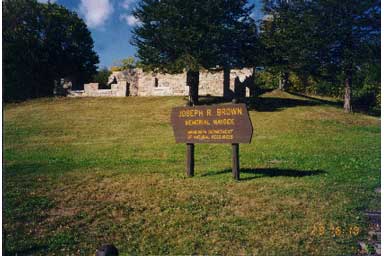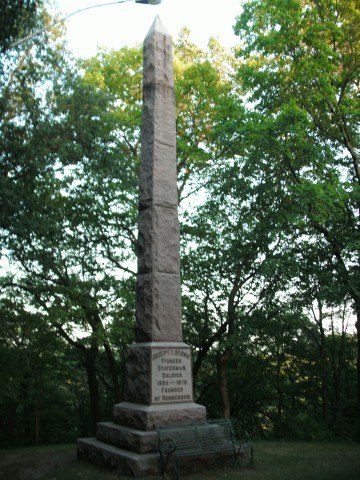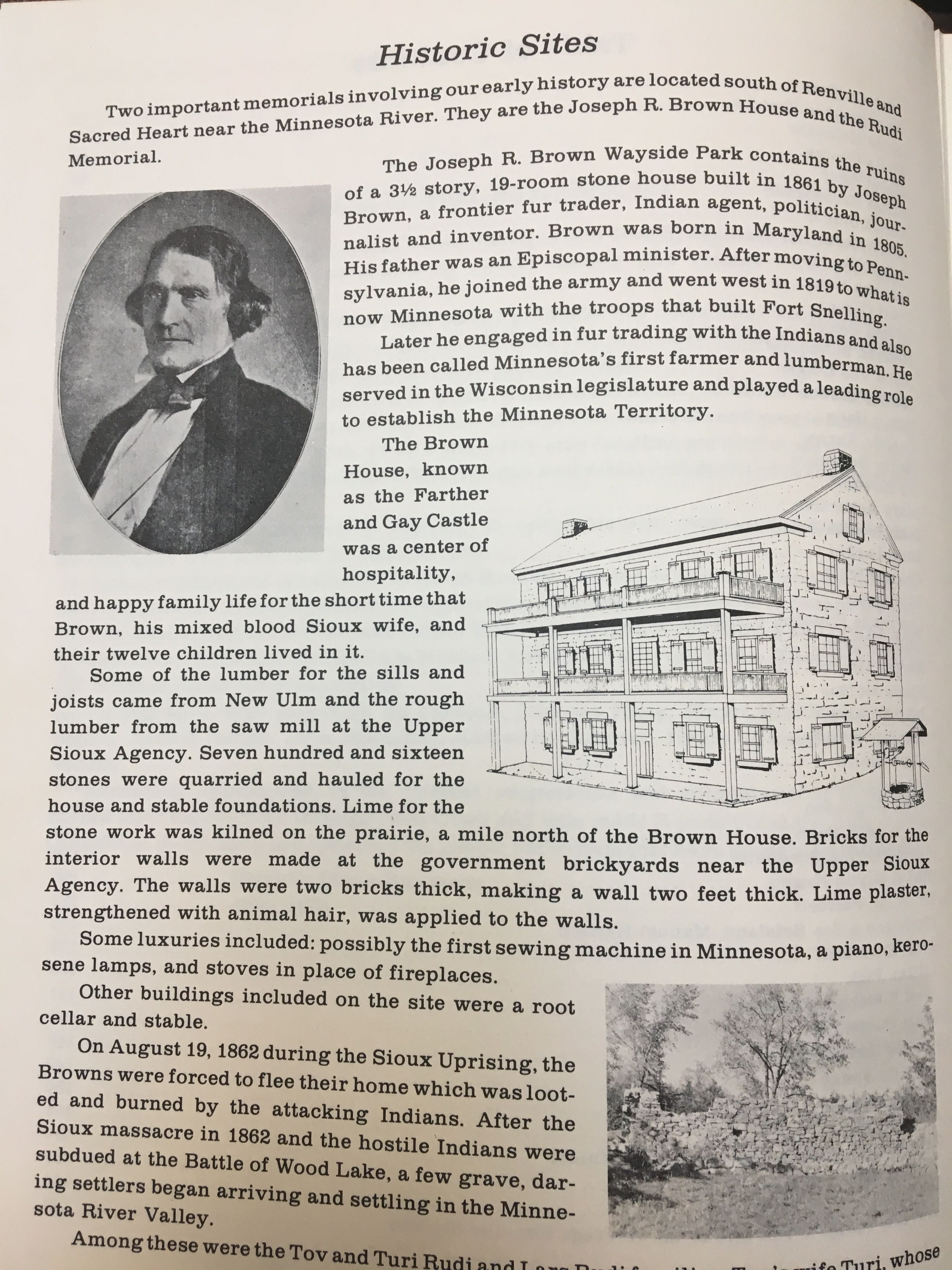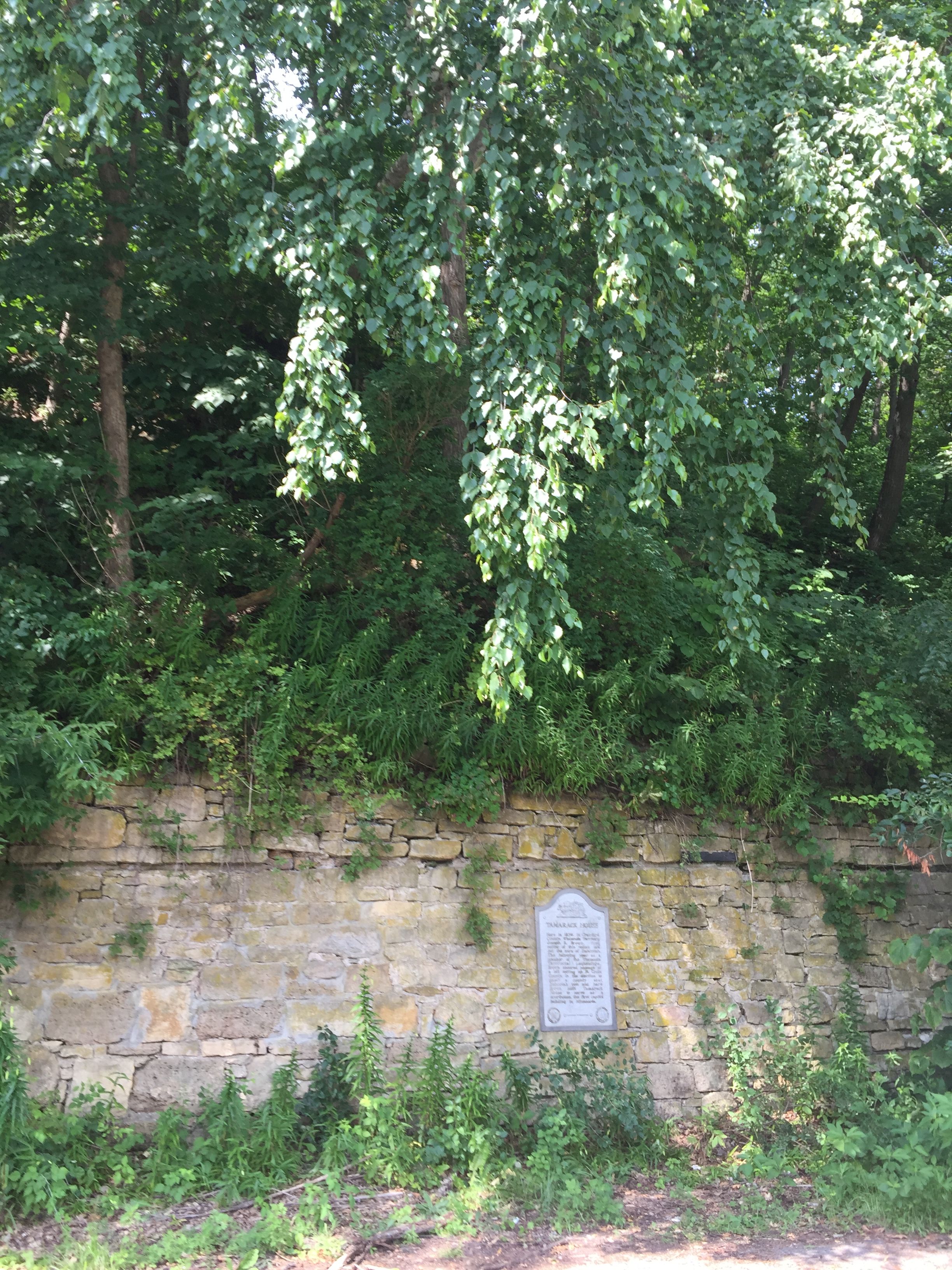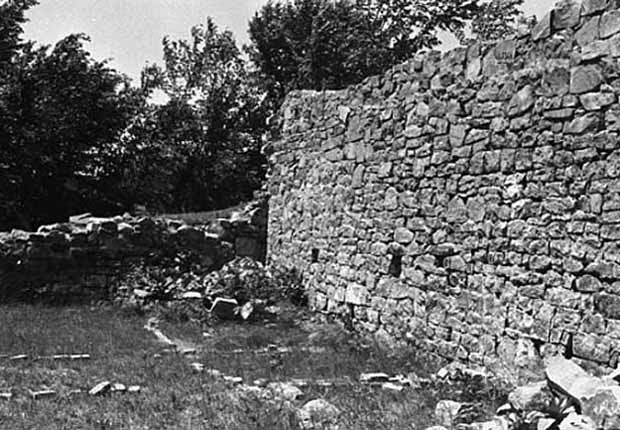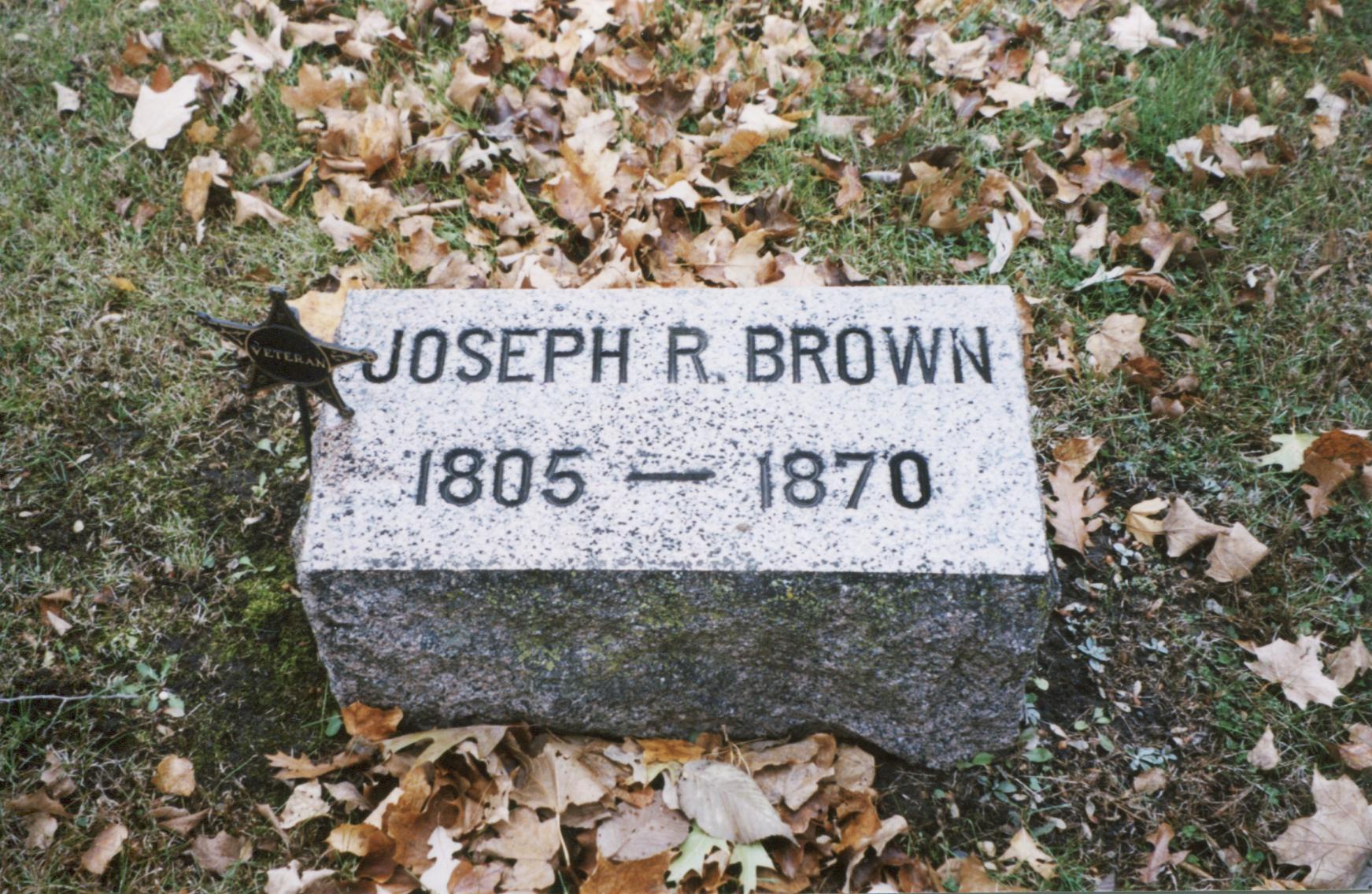---------------
From 'Fifty Years in the Northwest' by W. H. C. Folsom, 1888, pgs 52-53:
"Joseph Renshaw Brown, one of the best known of the pioneers, came to Dakotah, Schulenberg's addition, in 1839. For items in his history I am personally indebted to him. He was born in 1805, and, when old enough, apprenticed to a printer. On account of ill treatment he ran away and enlisted in the United States army [sic] at the age of fourteen years, serving as a drummer boy. He came with the army to the Northwest Territory in 1819. After enlistment he made his first home at Gray Cloud on the Mississippi, where he married a half-breed woman. Wisconsin history says she was the daughter of Robert Dickson, Indian trader and friend of the English in 1812. He learned and spoke the Chippewa and Sioux languages fluently. In 1839 he founded the town of Dakotah, at the head of Lake St. Croix, and erected some log buildings. Through his influence, in part, St. Croix county was organized, and the county seat located in Dakotah.He built here a two story log court house, which, the county failing to pay for, was left upon his hands.
He kept a trading station, was clerk of the county court and county commissioner. He filled several offices of trust and was by far the most important and universally serviceable man in the new county of St. Croix. In 1843 he left Dakotah, and returning to Gray Cloud, continued his Indian trade at that point and further west by means of branch houses. He was a member of the territorial Wisconsin legislature two sessions at Madison. He returned to Stillwater in 1848, left again in 1849, and in 1850 removed to St. Paul, where in 1852, he purchased of Mr. Goodhue the 'Pioneer', then the leading Democratic paper of the Territory. Mr. Brown was chief clerk in the Minnesota territorial legislature during the sessions of 1849, 1850 and 1851. In 1854 and 1855 he was a member of the territorial council.
In 1857 he was a member of the Democratic wing of the constitutional convention. During his residence in St. Paul he was interested in building up the town of Henderson, to which place he ran a stage line from St. Paul. About this time, also, he busied himself with the invention of a steam wagon, calculated to traverse the western plains and drag after it trains of cars. Financial and other difficulties prevented the completion of his design, which, however, he never entirely abandoned during the remainder of his life. In fact he went East in 1870 expressly to get his invention perfected, but from this journey he never returned. He died somewhat suddenly in New York in that year.Mr. Brown was a man of iron will and muscular frame. He owed but little to schools, but was a close observer of men and of the timies in which he lived.
He was a genial companion and true friend, and a man of honorable principles. He was a rugged but generous nature. He was public spirited, far seeing and far reaching in his plans. He believed in the great Northwest. He predicted its future greatness as a wheat growing and agricultural country, and, as far back as 1839, predicted that a great city would rise at the head of Lake St. Croix or at the Falls of St. Anthony. Yet so little schooled was he in the wisdom of the speculator that he sold the property in St. Paul now known as Kittson's addition, and worth several millions of dollars, for one hundred and fifty dollars, and a lot on Third street, now valued at $25,000, for a box of cigars."
---------------
From 'Fifty Years in the Northwest' by W. H. C. Folsom, 1888, pgs 52-53:
"Joseph Renshaw Brown, one of the best known of the pioneers, came to Dakotah, Schulenberg's addition, in 1839. For items in his history I am personally indebted to him. He was born in 1805, and, when old enough, apprenticed to a printer. On account of ill treatment he ran away and enlisted in the United States army [sic] at the age of fourteen years, serving as a drummer boy. He came with the army to the Northwest Territory in 1819. After enlistment he made his first home at Gray Cloud on the Mississippi, where he married a half-breed woman. Wisconsin history says she was the daughter of Robert Dickson, Indian trader and friend of the English in 1812. He learned and spoke the Chippewa and Sioux languages fluently. In 1839 he founded the town of Dakotah, at the head of Lake St. Croix, and erected some log buildings. Through his influence, in part, St. Croix county was organized, and the county seat located in Dakotah.He built here a two story log court house, which, the county failing to pay for, was left upon his hands.
He kept a trading station, was clerk of the county court and county commissioner. He filled several offices of trust and was by far the most important and universally serviceable man in the new county of St. Croix. In 1843 he left Dakotah, and returning to Gray Cloud, continued his Indian trade at that point and further west by means of branch houses. He was a member of the territorial Wisconsin legislature two sessions at Madison. He returned to Stillwater in 1848, left again in 1849, and in 1850 removed to St. Paul, where in 1852, he purchased of Mr. Goodhue the 'Pioneer', then the leading Democratic paper of the Territory. Mr. Brown was chief clerk in the Minnesota territorial legislature during the sessions of 1849, 1850 and 1851. In 1854 and 1855 he was a member of the territorial council.
In 1857 he was a member of the Democratic wing of the constitutional convention. During his residence in St. Paul he was interested in building up the town of Henderson, to which place he ran a stage line from St. Paul. About this time, also, he busied himself with the invention of a steam wagon, calculated to traverse the western plains and drag after it trains of cars. Financial and other difficulties prevented the completion of his design, which, however, he never entirely abandoned during the remainder of his life. In fact he went East in 1870 expressly to get his invention perfected, but from this journey he never returned. He died somewhat suddenly in New York in that year.Mr. Brown was a man of iron will and muscular frame. He owed but little to schools, but was a close observer of men and of the timies in which he lived.
He was a genial companion and true friend, and a man of honorable principles. He was a rugged but generous nature. He was public spirited, far seeing and far reaching in his plans. He believed in the great Northwest. He predicted its future greatness as a wheat growing and agricultural country, and, as far back as 1839, predicted that a great city would rise at the head of Lake St. Croix or at the Falls of St. Anthony. Yet so little schooled was he in the wisdom of the speculator that he sold the property in St. Paul now known as Kittson's addition, and worth several millions of dollars, for one hundred and fifty dollars, and a lot on Third street, now valued at $25,000, for a box of cigars."
Family Members
-
Solomon William Dickson Brown
1826–1841
-
![]()
Margaret Jane Brown Courturier
1835–1887
-
![]()
Lydia Ann Brown Rice
1836–1885
-
![]()
Angus Mitchell Anderson Brown
1837–1886
-
Mary Ann Brown Brunell
1838–1912
-
![]()
Ellen Brown Allanson
1841–1928
-
![]()
Samuel Jerome Brown
1845–1925
-
![]()
Emily Mary Ann Brown Parker
1847–1911
-
![]()
Amanda Cecelia "Manda" Brown Hines
1847–1925
-
![]()
Augusta Marie "Gussie" Brown Robertson
1850–1941
-
![]()
Joseph Renshaw Brown Jr
1851–1930



















